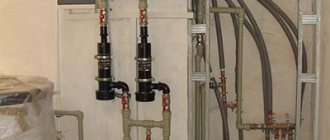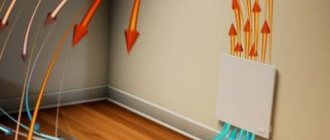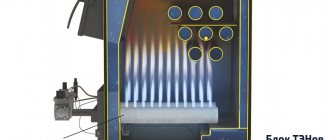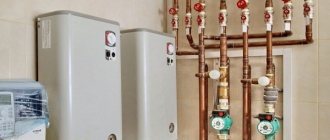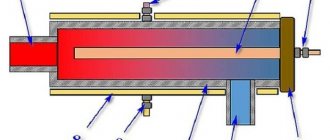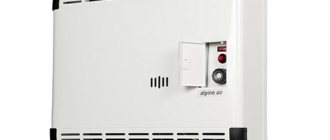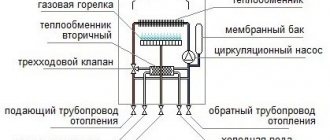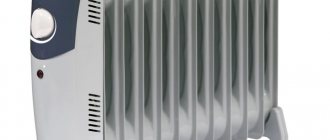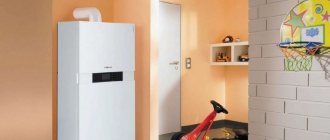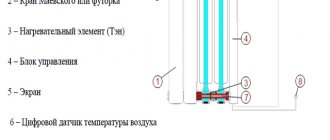The heating element allows you to heat the room without using a coolant (water or oil). In convector-type heating devices, air is heated by direct contact with the surfaces of the heater. The device circuits used by manufacturers make it possible to obtain a heating effect even at a low temperature of the working element.
Types of heating elements
A convection heater uses the natural upward movement of warm air. To increase its temperature, a heating element is needed. Its peculiarity is its large surface in contact with air. This is achieved in different ways, which is why heaters for convectors are produced in different versions.
The types of elements are not too numerous:
- needle;
- tubular (TEN);
- monolithic;
- ENGLU, or tape.
All types of heaters have advantages and disadvantages, so when choosing a device for heating rooms, you should pay attention to the type of element installed in it.
Needle type heating elements
The design of such a heater consists of a dielectric plate densely stitched with nichrome wire. Due to the manufacturing features, a needle-shaped heating element for a convector is also called a stitch or stitch. The metal thread forms numerous loops on both sides of the base. It is coated with a special heat-resistant varnish to insulate it from oxygen, so it lasts quite a long time.
The total heating surface of the stitch element is large enough to heat the mass of air passing through it. Most often, manufacturers install 2 needle elements.
Among the advantages of a needle heater are:
- almost instantaneous achievement of a working state: thin threads heat up to a high temperature (more than +250°C) in a few seconds and immediately begin to heat the air passing through them;
- Stitch elements are considered the most economical and inexpensive;
- The heating device operates silently.
Needle elements are used in Neoclima household convectors, in thermal curtains and fan heaters.
The main disadvantage of an element of this design is its vulnerability to moisture. Convectors with stick heaters are not recommended to be installed in a room with high humidity (bathroom, toilet, etc.).
How to choose a quartz monolithic heater for an apartment or home
A monolithic quartz heater is one of the most efficient electrical heating devices today. Heating systems based on quartz monolithic heaters include a certain number of devices connected in parallel. Their temperature is regulated by several thermostats.
What are monolithic quartz heaters for home?
Externally, the quartz electric heater is a panel that is decorated with an embossed pattern. There are models with a smooth front panel. The plate has a small thickness - about 25 mm. It is designed to be mounted on a wall or installed on the floor on a special stand.
Why is it needed and where is it used?
Heating systems based on quartz heaters are used in private and industrial premises. Such emitters are often installed in painting booths, which speeds up the drying process of painted surfaces.
The areas of application of quartz heaters are divided into the following groups:
- heating of apartments and private houses;
- heating of open areas;
- use in production - paint and varnish, woodworking, etc.;
- heating of premises in medical institutions.
Monolithic quartz heaters are especially often used in medicine. This is explained by the beneficial effect of such devices on the human body.
What it looks like: interior photo
How it works: device and principle of operation
The design of monolithic quartz heaters consists of:
- body filled with molten quartz sand of the highest quality,
- marble chips are added to it,
- Inside the device there is a heating element - chromium-nickel spiral
The current passing through it heats both the element itself and the quartz sand. The temperature of the spiral can reach 980 degrees.
However, the average operating temperature of the element is 120 degrees.
The case takes a long time to heat up and cools down over a long period of time. Even if there is a power outage, such a heater will provide heat to the room for a long time.
However, quartz devices cannot cope with rapid heating.
It takes them 20 to 25 minutes to reach the operating temperature of the stove at +95 degrees.
The operating principle of monolithic quartz heaters is reminiscent of the functioning of a Russian stove, which accumulates heat and releases it into the room for a long time. This effect is possible due to the properties of quartz.
The design of the device ensures the process of natural convection - cooling air is drawn into the gap between the wall and the heater. Here it heats up, rises and comes out at the top of the device.
One of the decisive criteria when choosing heating equipment is safety of use.
Monolithic quartz heaters are characterized by high fire safety. This is achieved by insulating the heating element. It is placed inside the device and does not come into contact with air.
It cannot heat up above +95 degrees. This indicator is not enough to melt the body, since the melting point of quartz sand is 1700-1728 degrees. In addition, manufacturers equip devices with protective grilles, the presence of which eliminates the possibility of accidental burns.
Reviews of monolithic quartz panels: pros and cons
Judging by user reviews, quartz heaters have several significant advantages:
- They don't dry out the air. Since the chromium-nickel spiral is placed inside the housing, it does not come into contact with air.
- Low electricity consumption. You can heat a room of 16-18 m2 with a heater that consumes only 0.4 kW/h. Heating a house with an area of 100 m2 will require the installation of 6 devices. Each of them will operate during the entire heating season for about 1800 hours. When calculating the total amount of energy consumed, the operating time of the devices is multiplied by the power consumption - 1800 * 0.4 = 720 kW/h. The cost of heating a house with such a system is 720 kW/h * 2 rubles. * 6 units = 8640 rubles for the entire heating season.
- Long service life - more than 25 years. During service, only the network cable may fail, but it is easy to replace it with your own hands.
- Possibility of installation in rooms with high humidity.
- Easy to install.
The disadvantages of quartz heaters include their heavy weight and relatively high cost. Some users pay attention to the following features of the devices:
- Peculiar appearance.
- The fragility of the slab - after a slight mechanical impact, chips and cracks may remain on it.
- High surface temperature in the absence of a decorative screen.
- Inability to adjust the degree of heating. When installing a thermostat, installation of the heater and wiring becomes more complicated. It is beneficial to create automatic temperature control when there are several devices. In this case, the temperature in the room is maintained automatically, preventing excess energy consumption.
As you can see, the advantages of quartz heaters outweigh the disadvantages.
Manufacturers and popular models: ranking of the best and prices
Popular models from well-known manufacturers:
Nikapanels 200
The maximum consumption per hour is 0.2 kW. The device is designed to heat rooms of 4 m2. Device power - 200 W. The weight of the device is 7 kg. The cost of Nikapanels 200 starts from 3,700 rubles.
MKTEN-0.5/220
The rated power of the device is 0.5 kW. The highest temperature of the radiating surface is 95 degrees. The weight of the device is 10 kg. The work surface heats up in 20 minutes. The cost of the device is 2500 rubles.
Energy-saving heater TeplEko
The power consumption of the devices is low - 400 W. Based on these heaters and smart GSM sockets, you can create a heating system that allows you to maintain a comfortable temperature at home. The weight of the device is 12 kg. The cost of the equipment is 2500 rubles.
TeploPlit
The heater consists of quartz sand, ground marble and white clay. This composition is mixed, compacted and sintered. The heating element, which is placed inside the device, is isolated from the environment. It is not subject to oxidation. Device power - 450 W. The device heats a room of 9 m2. The price of the equipment is 3500 rubles.
EXO 380
The wall-mounted model is designed to heat rooms up to 4 m2 in winter and up to 8 m2 in spring/autumn. The device reaches an operating temperature of 95 degrees after 30 minutes of operation. The cost of the heater is 2400 rubles.
These heaters are in demand among consumers due to their optimal price-quality ratio.
Which manufacturer and which type is better to choose: TOP-3
When choosing a heater model, you should take into account its minimum power. Many consumers pay attention to the cost and appearance of the device.
Minimum required power of the device
You can calculate the required power of a quartz heater in the following way:
- Calculate the volume of the room. To do this, the area is multiplied by the height of the ceilings.
- Divide the result by 30 (special coefficient).
For example, the area of the room is 18 m2, and the height of the walls is 2.7 m. After multiplication, the cubic capacity is 48.6 m3. After dividing the volume by 30, the result is 1.62 kW. This power of the device is enough to maintain heat in the room. In general, we can say that for 10 m2 a heater of up to 1 kW/h is needed.
For rooms located on the north side or in the corner, the calculated productivity is increased by 20%.
What else to consider when choosing a device?
Monolithic quartz heaters are usually purchased for large houses located in the average climate zone. These devices are not intended for areas of the Far North or Siberia, where temperatures can drop to -30 degrees in winter.
In addition to power, when choosing, take into account the method of mounting the device. The most convenient option is to purchase a wall-mounted model. This solution saves space.
3 best models
Among the best heaters are:
- MKTEN-0.5/220. The device has a power of 0.5 kW. Heats up to 95 degrees in 20 minutes. The price of the device is 2500 rubles.
- TeploPlit. The power of the device is 0.45 kW. The device is capable of heating a room of 9 m2. The cost of the device is 3500 rubles.
- Nikapanels 200. The power of the device is 0.2 kW. The cost of the device starts from 3,700 rubles.
These heaters have an optimal price/quality ratio.
Price
The initial cost of quartz monolithic heaters is 2,500 rubles. The price of devices depends on the rated power and heating area. The maximum cost of models of this type is 5,000 rubles.
Where to buy a quartz monolithic heater for an apartment or house?
When choosing a quartz heater, you should contact well-known household appliance stores. Many options can be found in Moscow and St. Petersburg.
In Moscow
The following stores are popular among consumers in the capital:
- "Buran". The store address is Volgogradsky Ave., 32 bldg. 8. Telephone.
- "TepplEco". Located at st. Montazhnaya 9, Mandarin shopping center, room B1-6, 1st floor. Telephone .
- "MAXIQUARTZ". The store address is Vysokovoltny Ave., 13A. Telephone .
These stores have a large selection and competitive prices.
In St. Petersburg
You can purchase a monolithic quartz heater in St. Petersburg in the following stores:
- Online store "Salon-Warm-Floors". Located at Russia, St. Petersburg, Yuzhnoye Highway 37, MULTIMEX Construction Fair, hall No. 2, section 1B. Telephone .
- "ClimateVSBP". The store address is St. Petersburg, Sea Glory Square 1, 2nd floor, office 307. Telephone.
- "Thermal engineering". The company address is St. Petersburg, Moskovskoe highway, building 7A. Contact phone number
Safety precautions and operating features
To ensure a long service life of a quartz heater, a number of requirements must be met:
- the device must be grounded;
- Cleaning of devices is carried out after disconnecting from the network and completely cooling4
- It is prohibited to move the device by pulling the cable;
- It is not recommended to stay in close proximity to the device for a long time.
Compliance with the rules for using electrical appliances allows you to maintain health and extend the life of the equipment.
May 12, 2018ventsyst
Tubular type heating elements
Tubular heating elements for convectors (heating elements) are more protected from external influences than the previous type. Their nichrome thread is enclosed in a metal tube filled with loose dielectric. Quartz sand is most often used as backfill. When an electric current passes through a nickel-chromium alloy, the wire or spiral heats up to + 200°C or slightly higher, gradually heating the filler. The process of heating the heating element to operating temperature takes longer than that of a needle heater.
To increase the heat transfer surface of a tubular heater, manufacturers fin the heating element: they attach spiral or flat metal ribs to a tube with a heating coil, which also become very hot during operation. Each manufacturer develops its own heat-exchange fin design, but the air heating efficiency is approximately the same for all similar designs.
The advantage of a convection heater with heating elements is its complete safety and reliability. The tube with the heating filament inside is closed at both ends with dielectric plugs, and the spiral inside the tube is reliably protected from moisture and water droplets. The relatively low heating temperature of the nichrome thread allows tubular heaters to last 1.5-2 times longer than the previous ones.
You can install a convector with tubular finned heat exchangers in any room. Heating elements for convectors are most often made in a splash-proof version. This is evidenced by the IP24 marking in the technical documentation for the product. But even a splash-proof device is not recommended to be placed closer than 60-100 cm to water sources (shower, tap or edge of the bathtub). Atlantic or Thermor convectors are most often made using heating elements.
Among the disadvantages, the high energy consumption of devices equipped with heating elements is noted. Such convectors also have a slightly higher price than the previous type. Powerful convectors tend to crack during operation or cooling due to uneven expansion of the metal.
Design and principle of operation of the convector
The efficient operation of the electric heater is ensured by natural convection (circulation) of air in the room . As mentioned above, the main element of the device is the heating element for the convector, placed in a metal case, which most often has a rectangular shape.
The operating principle of the electric heating device is as follows. Cold air enters the housing through holes in its lower part. When heated, the air masses rise upward and return back to the room through the holes on the front surface of the convector. Gradually cooling, the air falls down again, and the cycle repeats again.
Important! Continuous circulation of cold and warm air ensures fast and efficient heating of the room in which the electric convector is installed.
On the domestic market, potential consumers can find convectors equipped with open and closed electric heating elements.
- Devices with open-type heaters are equipped with a mechanical temperature controller and are characterized by low cost, ease of control and rapid heating of the housing. However, their degree of electrical protection does not exceed IP21.
- Devices with closed-type heaters are more expensive, have a number of preset operating programs and additional options, and are equipped with an electronic thermostat. They are characterized by low power consumption and an increased degree of electrical protection (IP24).
The type of electric convector should be selected based on the characteristics of the heated room.
Monolithic heating elements
In a monolithic heating element, a nichrome spiral is located in the thickness of a solid heat exchange structure made of aluminum. The gap between the heater and the metal is filled with a dielectric, which also serves to transfer heat from the element to the finned heat exchanger.
Due to the solidity of the ribbed structure, all its parts expand equally. Convection heating devices with monolithic heat exchanger parts do not have the disadvantage of products with heating elements: they do not crackle when heated, operate silently and are durable.
The degree of protection against moisture for most of these devices meets the IP24 standard. Monolithic elements can be used in wet rooms, but they also have restrictions on installation no closer than 60 cm to water.
The main disadvantage of a convector with a monolithic type heater (for example, NOBO products) is its high price. The average cost of the device is 1.5 times higher than the amount that can be paid for a convector with a heating element.
Band type heating elements
Tape heaters (ENGL, ENGLU) look like a thin fiberglass strip. The longitudinal base of the tape is formed by nichrome threads braided with a thin fiberglass cord. For better insulation, the product is impregnated with organosilicate composite material.
The small thickness of such a heating system makes it convenient for use in snow melting systems and heating communications (water supply, sewerage, etc.). Heating of the surface of the tape can reach +400°C, therefore it is not used in household convectors. The tape heater does not have a heat exchange part, and heating of the air or any surface occurs in direct contact with the ENGLU tape.
The varieties of tape heaters produced have a given length. They cannot be shortened or cut. When choosing such a heater, you need to find a product that is suitable in length (from 4.1 to 20 m) and power density (50-300 W/m). Most ENGLU tapes are not waterproof and cannot be used in a humid environment.
Diagnostics of heating elements for electric convectors
In general, a convection heater is a fairly simple device with a small number of components built inside. The basis of the device is one or more heating elements capable of generating heat. If they malfunction, the convector stops heating the room. You can make sure that it is the heater that has failed only by testing it.
As a rule, modern convectors are equipped with closed-type heaters. Their open structures are extremely rare. In the event of a breakdown, a closed heating element is replaced - it cannot be repaired. It is best to check its performance using the simplest multimeter (tester) turned on in resistance measurement mode.
The resistance of the heating element is measured as follows:
- disconnect the power cable;
- set the resistance measurement limit on the multimeter to 200 Ohms;
- apply the tester probes to the contacts of the heating element;
- Based on the readings that appear on the multimeter display, a conclusion is drawn about the serviceability of the heating element.
The heating element is operational if the measured resistance value does not exceed several tens of ohms. In cases where the display shows “0” (short circuit) or the “infinity” icon (break), we can conclude that the heating element is faulty and must be replaced.
So, when choosing a convector, you should first of all find out the type of heating element used. This determines in which room it can be used for its intended purpose. And during operation, you must follow the rules and recommendations indicated by the manufacturer of the equipment in the user manual. This is necessary so that the electric heater lasts as long as possible, since it cannot be repaired.
Criterias of choice
Taking into account the characteristics of each type of heating element, you can choose one that is suitable for the specified purposes or the room where it will be used. If heating speed does not matter, it is better to choose durable and reliable heating elements or monolithic heaters. At a higher price, they will be able to work for a long time.
For long-term operation and slight but constant heating of the air, preference should be given to a monolithic system. A developed heat exchanger allows you to save energy even during long-term operation of the device: it can be turned on at full power to achieve operating temperature or rapid heating and left to maintain the desired temperature at ½ power.
Which type of thermostat should I choose - electronic or mechanical?
Convectors are equipped with two types of thermostats: mechanical and electronic. The name of the thermostat reveals the principle of temperature measurement. In the case of a mechanical thermostat, a capillary air thermostat is used to measure the room temperature. An electronic thermostat uses a microcontroller and a thermal resistance to measure temperature. For the end user, this information is not so necessary; other differences are more important: an electronic thermostat is more accurate than a mechanical one (measurement accuracy is 0.1-0.3 C versus 1-2 C for a mechanical one) and the convector with an electronic thermostat operates silently. A special feature of convectors with a mechanical thermostat is a characteristic “click” when the convector turns the heating on and off. However, convectors with “mechanics” are cheaper and, so to speak, more “oaky”. At the same time, the accuracy of electronic thermostats allows you to save an additional 5-7% of electricity.
The controls for convectors with “mechanics” and “electronics” may not differ. For European manufacturers, this is usually a rotating knob or a moving slider for setting the temperature, as well as an operating mode switch (if there is one).
If you see a convector with an LCD screen, a remote control, power switching, some kind of “ionizers” and other “whistles and tricks” - 99% that this is a Chinese-made product.
